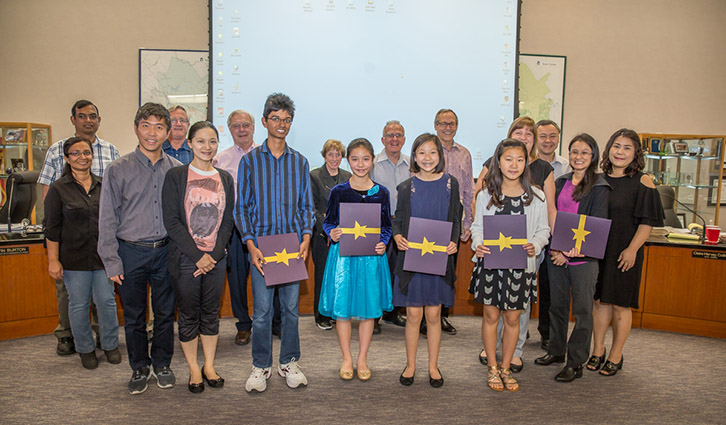-
Published: Jun 05, 2018 | 10:11 AM
2018 IUSD Science Fair Winners Commended at IRWD Board Meeting
At the May 29 board meeting, IRWD staff and board members recognized a group of young students for their top water-related projects in the 2018 Irvine Unified School District Science Fair. Students were awarded certificates and their projects were displayed at the IRWD Sand Canyon office. Read on to learn about the scientific achievements of each of the students.
“Will it Melt?”
By Beverlyn Tsai and Jane Jeon, sixth-graders at Beacon Elementary School
Beverlyn Tsai and Jane Jeon performed research on how salt added to purified water affects the rate at which it melts. They froze and tested five different saturations of salt and timed the rate at which each one melted. Their experiment found that the more salt that was added to water, the faster it would melt. They concluded that useful applications for this finding would be to use salt in defrosting freezer foods and to clear icy roads in winter.
“Nitrate Uptake by Algae”
By Krystal Tran, seventh-grader at South Lake Middle School
As a tropical fish owner, Krystal Tran knew that algae could be harmful to her fish, but she also wondered if it might also provide some healthful qualities to aquatic life. Her research looked into the benefits of algae in removing from water various nitrates (including ammonia) that can harm fish. She tested three types of algae, and measured and tracked nitrate levels in the water to determine that Nannochloropsis oculata — a fast-growing single-celled saltwater algae — removed the highest quantities of ammonia and nitrates from the water. Tran believes the Nannochloropsis oculata algae could be used effectively in treating wastewater.
“The Study of How the Concentration of Acetic Acid in Water Affects Plant Growth in Drought Conditions”
By Chamidu Sagara, freshman at University High School
Chamidu Sagara used pinto bean seeds to test how acetic acid — a substance that triggers a drought response in plants — can be used to help crops tolerate periods of drought. In his experiment, he planted five seeds, and watered them with a solutions containing various concentrations of 0%, 25%, 50%, 75%, and 100% acetic acid. Tracking the plants’ growth over 14 days, his research revealed that the 25% concentration performed best under simulated drought conditions — measuring more than three times the height of the control plant at 11.5 centimeters tall. Sagara believes acetic acid could offer a revolutionary approach to aiding crops during drought. But at this time, he noted, the cost of acetic acid is prohibitively high to be used for that purpose.
“Determining the Minimum Quantity of Moringa oleifera Seed Required to Reduce the Turbidity of Non-Potable Water”
By Jenna Schindele, junior at University High School
Jenna Schindele’s experiment set out to determine the minimum quantity of Moringa oleifera seed powder required to reduce turbidity of non-potable water. The Moringa oleifera is a tree native to northern India, which is also abundant in Southeast Asia, Africa, the Arabian Peninsula, South America and the Pacific and Caribbean islands. It contains a protein that binds with bacteria to flocculate impurities through the process of neutralization and absorption, followed by sedimentation.
Schindele created 15 test samples, each with different levels of the Moringa oleifera seed powder, and tested each sample for turbidity over time. Her conclusion was that lesser quantities of the seed powder were most effective at improving the turbidity of non-potable water. Recognizing that contaminated water causes more than 500,000 diarrheal deaths each year, Schindele believes the Moringa oleifera stands as a viable option of water treatment to developing countries unable to afford more costly treatments such as reverse-osmosis or chlorination.



